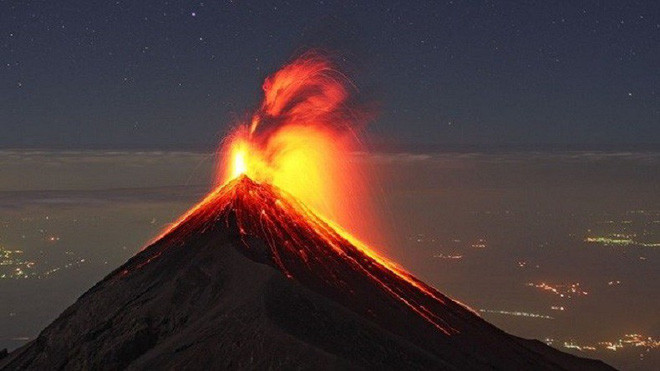This is why Guatemala's volcanic disaster is so terrible
Fuego volcano in Guatemala has created a very terrible disaster.
At the present time, Fuego in Guatemala on June 3 caused at least 62 deaths, 3,000 people to evacuate, and 1.7 million people were affected. This is one of the biggest volcanic disasters in years.

Fuego volcano in Guatemala erupted.
With a volcanic eruption, there will be two dangerous elements: ash and lava flow. However, in these two elements, lava is the most dangerous thing - at least in the Fuego disaster this time, when it is the main cause of pitiful deaths.
Looking at the lava flows very slowly, but why is it so dangerous?
It can be seen that the lava has shown signs from far away, with white smoke rising. Plus the speed is very slow, so anyone can avoid it.
But it looks like that, but it . is unbelievably harmful. The people in the video must say it is very fortunate to have just escaped death within a short time.
According to Dave McGarvie, a volcanic expert at Hull University, the lava flow is just a name.It is essentially a combination of molten rock, hot gas, and volcanic gas.
The temperature of these hot gases can be up to 600 ° C. And it looks so slow, lava can move extremely fast on steep terrain, with speeds of 100-300km / h, even up to 700km / h.

Column of smoke when lava flows down.
But not yet! Due to their heavy density, they create enough inertia to climb a slope in valleys or slopes. In it the most catastrophic is the first case, because valley cities only have a single path to enter, and lava is covered by it.
A disaster due to lack of understanding
McGarvie said, what surprised him most was that when people saw lava smoke, they stopped to take pictures. Although it is an interesting phenomenon, the thing to do is run as far as possible, especially when the smoke is tending to swoop down to where you are.
This proves that if people around Fuego are provided with more information about volcanoes, the damage to people may not have happened, or at least the number would be greatly reduced.
In fact, the Fuego volcano in recent years has also begun to work smoldering, but a disaster at this level is very rare. It caused the authorities to fall into an awkward situation.

In fact, Fuego volcano in recent years has also begun to work smoldering.
If you set up a safety belt around a volcano , residents will have to evacuate very early. In the worst case scenario, they would have to wait decades, even centuries, to wait for the volcanic eruption but nothing happened. Meanwhile, land resources around volcanoes are very fertile, who can hold hearts?
Deadly incidents
One of the most terrible examples of disasters caused by lava, is the Pelée volcano event on the island of Martinique erupted in May 1902. The flow of lava then buried Sain-Pierre town, killing 30,000 people. Only a few survived, including one prisoner.
The town of Pompeii and Mount Vesuvius are also very typical examples of volcanic disasters. So to see that this Mount Fuego event is not the only volcano-related disaster in human history.

Pompeii disaster.
But the problem is that the lesson learned after that is just like the clouds flying. The reason is because like Mount Vesuvius, its latest eruption is . 700 years ago - that is too long.
According to volcanic experts, the frequency of an eruption may be once in centuries, even millennia. No one can stand as a living witness to such disasters.
Paradoxically, some time after the volcano erupted, the surrounding lands became extremely fertile. Residents will continue to live, so a few hundred, or a few thousand years later, their descendants once again flee, leaving behind less fortunate people to fall down.
- The most terrible volcanic disaster in human history
- The truth about a man who was crushed in a volcanic disaster
- Humans are smarter thanks to super disaster
- The man died carpet in the volcanic disaster 2,000 years ago
- 10 terrible disasters in human history
- Discovered horse corpses for nearly 2,000 years buried under volcanic ash
- The most horrifying genocide of humankind
- Sicily island volcano suddenly erupted, 10 people were injured
- 5 great disasters can happen tomorrow
- Fire causes frost
- The scene of the terrible volcanic eruption in Guatemala
- Obsessed the world's most terrible volcanic disasters
 Is the magnetic North Pole shift dangerous to humanity?
Is the magnetic North Pole shift dangerous to humanity? Washington legalizes the recycling of human bodies into fertilizer
Washington legalizes the recycling of human bodies into fertilizer Lightning stone - the mysterious guest
Lightning stone - the mysterious guest Stunned by the mysterious sunset, strange appearance
Stunned by the mysterious sunset, strange appearance Life could exist on Jupiter's moon
Life could exist on Jupiter's moon  Red hot lava flowing on snow causes confusion
Red hot lava flowing on snow causes confusion  Mysterious people lived in lava tubes 7,000 years ago in Arabia
Mysterious people lived in lava tubes 7,000 years ago in Arabia  Robot captures 320,000m2 lava field under the sea
Robot captures 320,000m2 lava field under the sea  Scientists reproduce the lava explosion
Scientists reproduce the lava explosion  Discovered an unprecedented depth of volcanic lava
Discovered an unprecedented depth of volcanic lava 